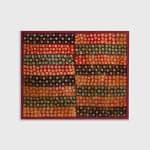Huari Culture 100 AD-1200 AD
63" x 51'1" in.
Further images
These tie-dyed ceremonial clothes were worn by Wari lords of the elite and the spread to different places in the Andes, many perhaps as diplomatic gifts that fostered alliances or as imports treasured for their prestige. The deeply saturated red/blue/green ground is punctuated by large white and yellow tie dye modules. The irregular arrangements confer upon these cloths a sense of movement and vibrating radiance. Huari tunics with vivid tie-dyed colours have an empowering visual allure.Two very different types of high status ritual textiles were produced with the use of the discontinuous warp and weft technique during the Huari sojourn on the coast regions creating these complex tie dyes, in which case the un-dyed cloth was woven in the same based technique, and cloth woven in multiple techniques, wherein discontinuous warp and weft technique is one of several weaves in a single textile.









